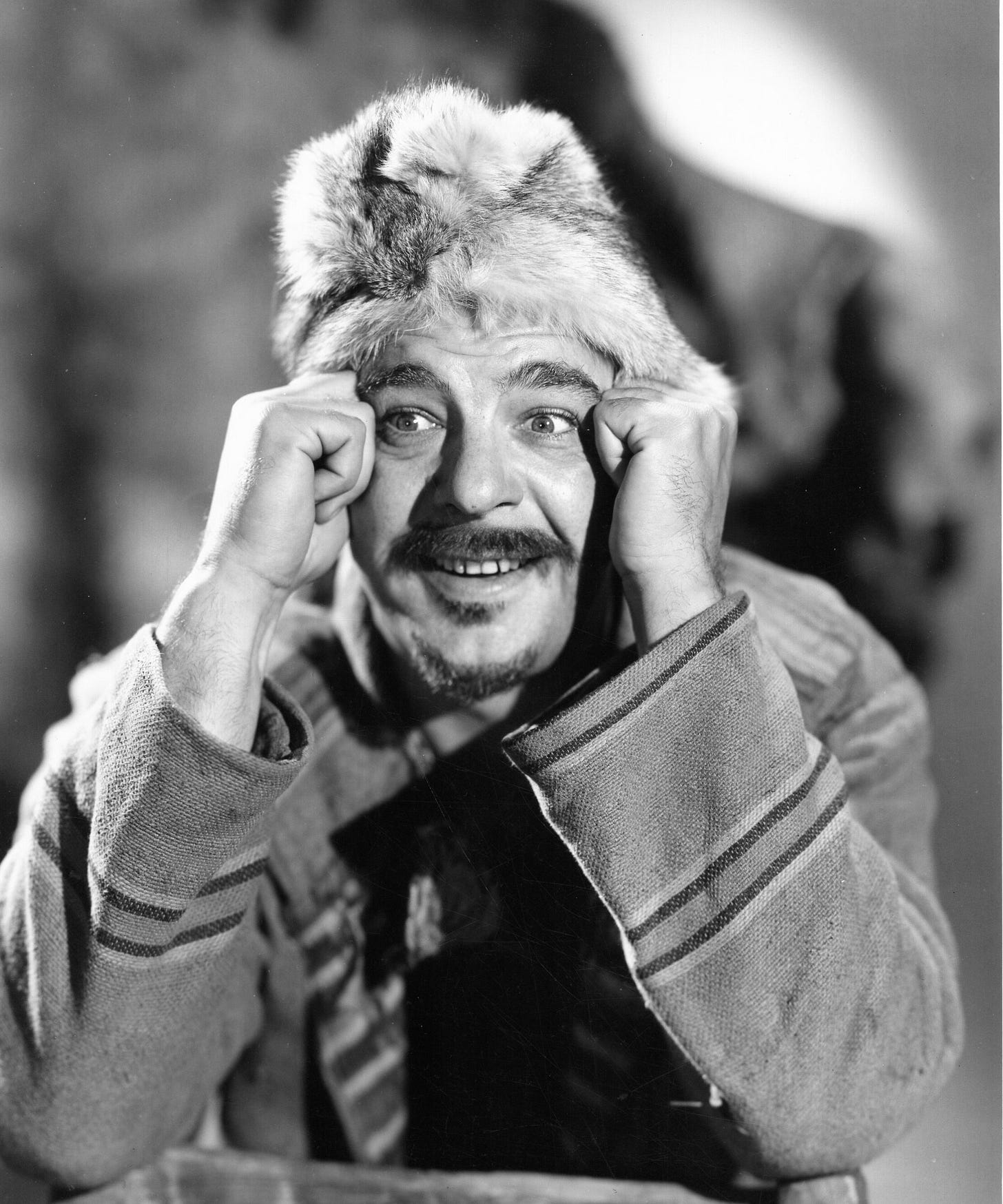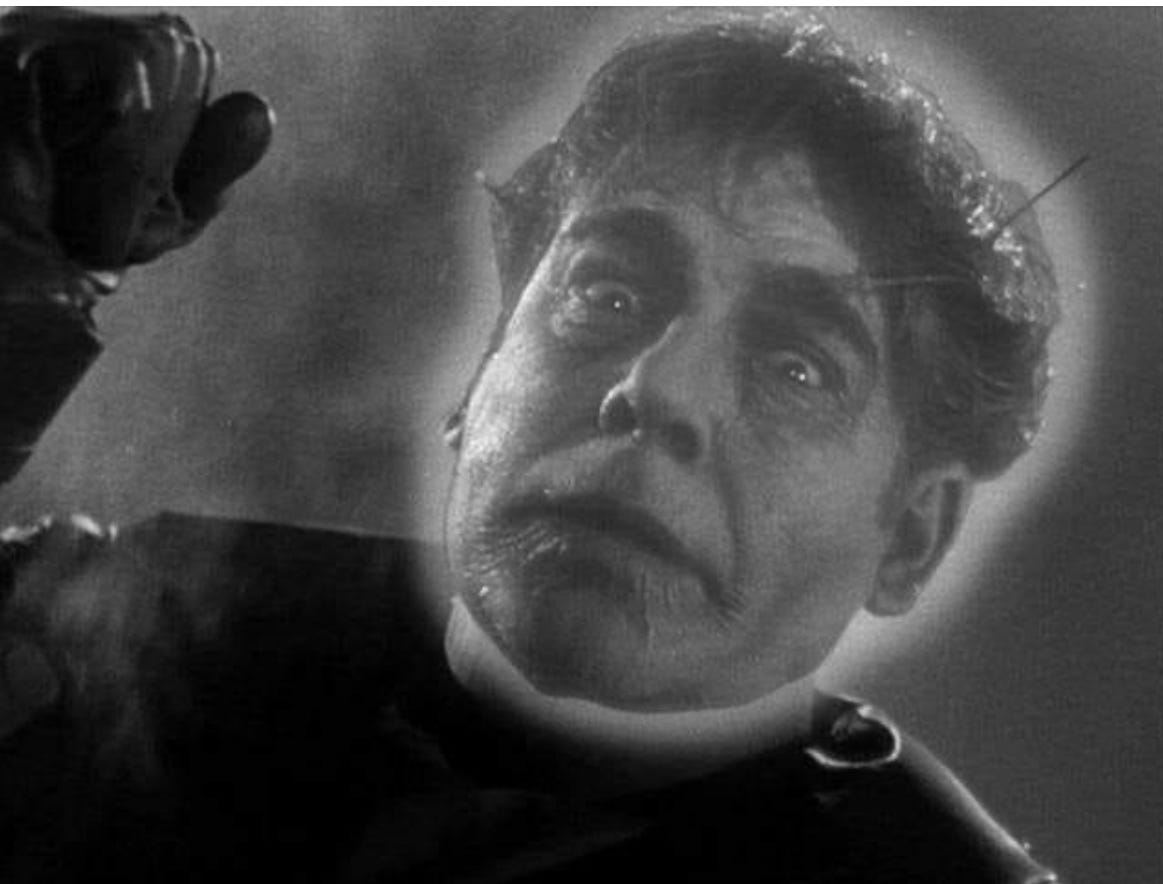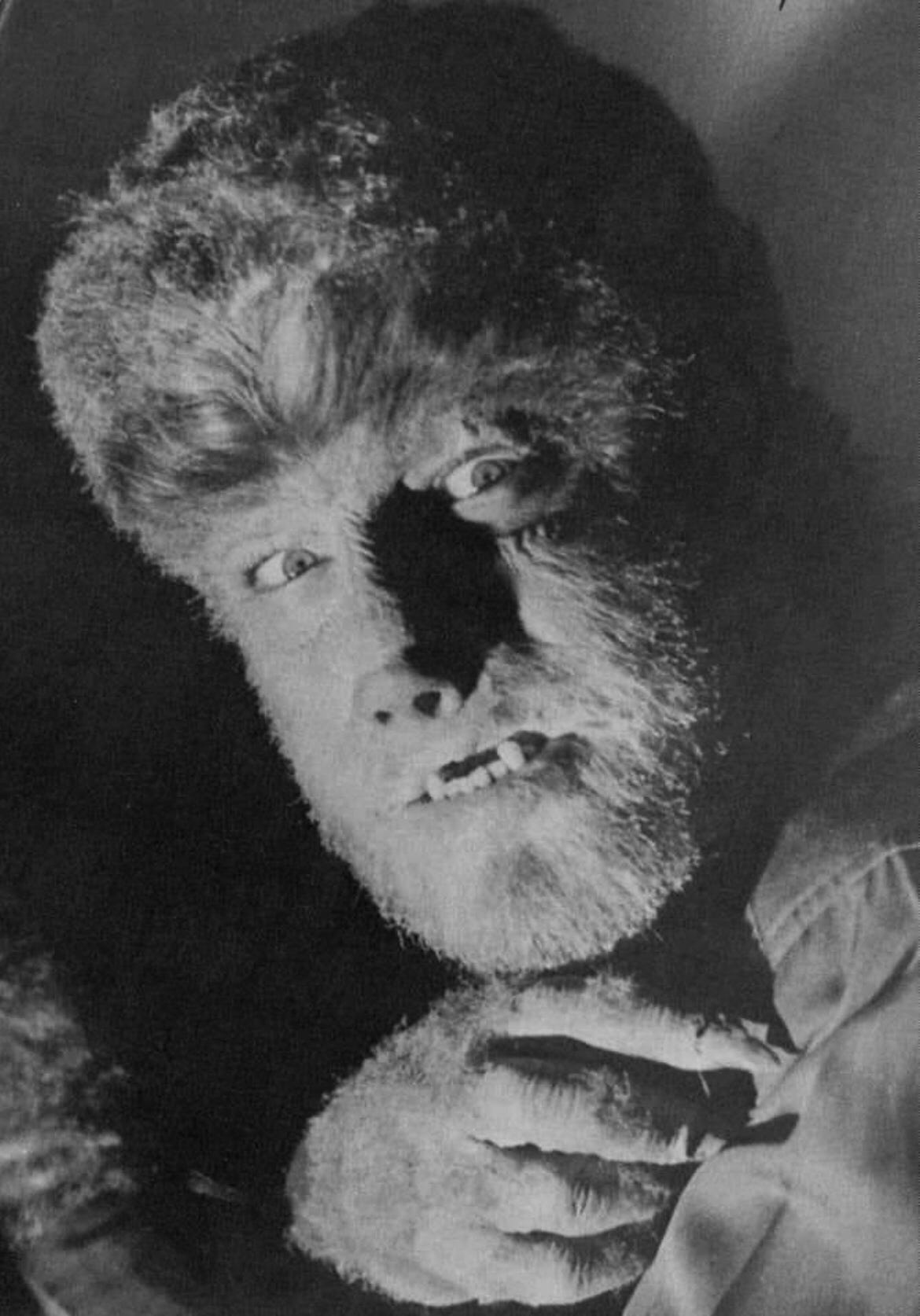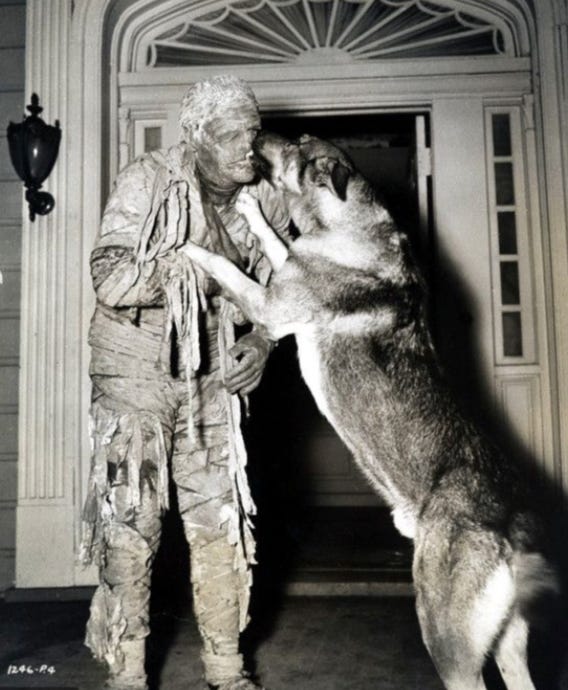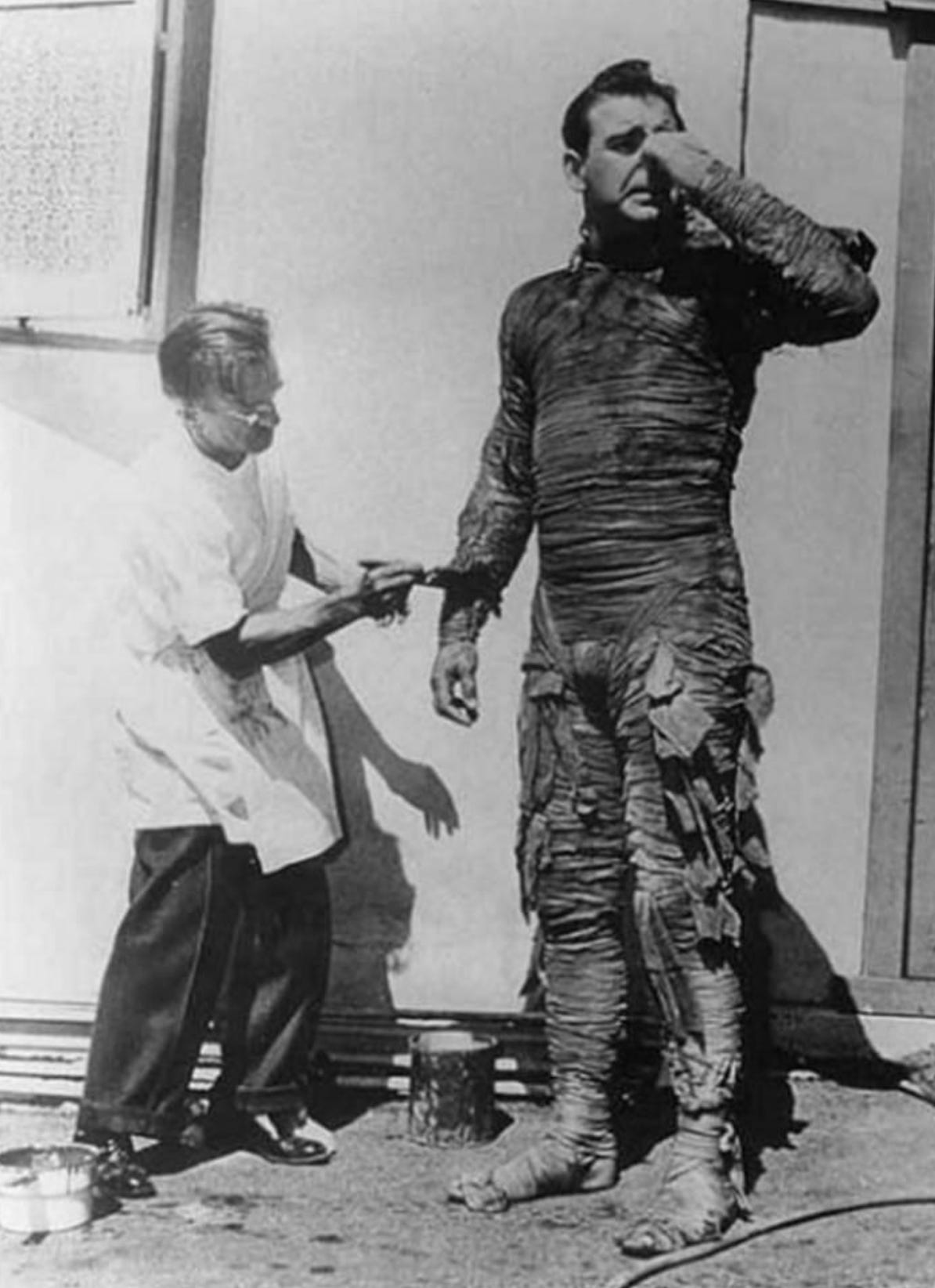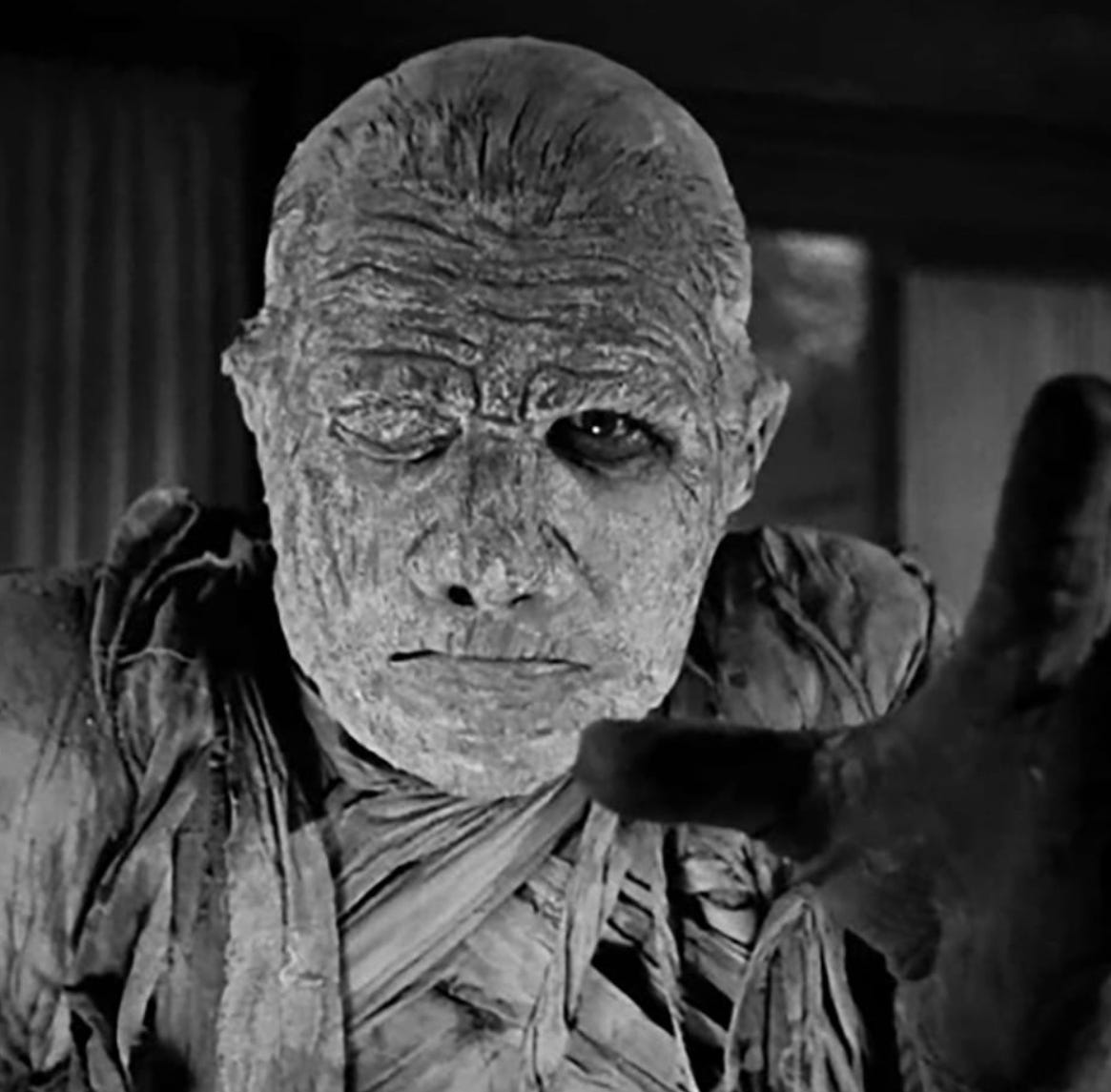Classic Horror Behind the Scenes: Why Lon Chaney Jr. Hated the Mummy
Most Monster Kids know that Chaney hated playing the Mummy. This month, we’ll examine exactly why.
By Bill Fleck, author of the Rondo-nominated book CHANEY’S BABY, available here.
Check out other articles on my Rondo-nominated website by clicking here.
Did you know? Two-time Rondo-Award winning filmmaker Thomas Hamilton is in the process of making THE CHANEYS: HOLLYWOOD’S HORROR DYNASTY, which is inspired by my book, CHANEY’S BABY. (I’m also a producer on the film.) If you’d like to support the project, click here and see what’s going on. Thanks!
“Anyone who ever got killed by the Mummy was an idiot!”
So decreed Mr. Mike DelGaizo, my 10th-grade social studies teacher and mentor in 1979.
Exactly how we got on the subject of the Mummy in the middle of Mr. D’s lesson on European history is lost to time. But since I was one of only about four Monster Kids in my graduating class—and the sole one in Mr. D’s room at the time—I’m sure I had something to do with it.
In any case, given that most folks back then thought of the Kharis version of the Mummy (if they thought of the Mummy at all) rather than Karloff’s Imhotep in the 1932 original, Mr. D was absolutely correct. [1] Kharis, played at first by Tom Tyler in 1940 and then by Lon Chaney, Jr. in three follow-ups, was not exactly fleet of foot. William K. Everson in CLASSICS OF THE HORROR FILM still provides the best support for Mr. D’s opinion on page 89:
“[S]tiffened with age and hampered by bandages, he is so slow-moving that escaping from his clutches is child’s play—and his movie victims invariably had to edge themselves into corners and, paralyzed with fright, patiently wait for him to lumber up to them and dispatch them with a one-handed stranglehold.”
Interestingly, Everson also accurately assesses the character of Kharis…or rather, the lack thereof:
“So unmenacing was the Mummy himself, that there invariably had to be a human villain as well—usually a high priest in the form of George Zucco, John Carradine, Eduardo Cianelli, or Turhan Bey—to keep the action even tolerably exciting.”
In other words, playing Kharis is not exactly a serious actor’s dream…especially if being recognized as a serious actor is an all-consuming obsession.
Ladies and gentlemen, let’s head back to the early 1940s and allow me to introduce you to Mr. Creighton Tull Chaney…better known as Lon Chaney, Jr.
We Monster Kids all know that Chaney has a dream: to be taken seriously as an actor. Or, rather, to be taken so seriously as an actor that he eclipses the memory of his famous father. (For the exact reasons why Chaney has this dream, see my book CHANEY’S BABY here…or, for a shorter version, check out this article on my blog).
Following a rough start under his own name, and a more-than-reluctant change to “Lon Chaney, Jr.” in early 1935, the actor is mostly trapped in Grade-C horse operas. The stereotyping really gets under his skin. But he finally sees a crack in the glass ceiling when his performance in John Steinbeck’s OF MICE AND MEN (1939) is almost universally lauded.
Suddenly, he’s a name to be reckoned with. The press even reports—mistakenly—that Chaney has been nominated for an Academy Award. [2] Producer Hal Roach plans to star him as privateer Henry Morgan in a follow up, Steinbeck’s CUP OF GOLD. Steinbeck himself is thrilled with Chaney’s performance as Lennie in MICE and believes that he’ll be perfect as Morgan, too.
Chaney is understandably ecstatic.
“I want to be a great actor more than anything else in the world,” he’ll enthusiastically state.
But in spite of the massive critical acclaim, OF MICE AND MEN doesn’t make much money. True, the film will prove to have legs as the years go by, but this can’t be predicted in 1940. As such, plans for CUP OF GOLD are scrapped.
And following an excellent turn as a cave man in ONE MILLION B.C. (1940), Chaney finds himself stereotyped once again, this time doing reprisals of Lennie in bits.
“It haunts me,” Chaney will later complain. “I get a call to play a dumb guy, and the director tells me not to be Lennie. But he’s never happy until I play the part like Lennie, and then he doesn’t know why he likes it!”
This isn’t going to help his dream come true.
[Above: Chaney reluctantly reprises Lennie in DeMille’s NORTH WEST MOUNTED POLICE (1940). Such roles left him feeling stereotyped.]
But miraculously, someone at Universal has seen Chaney in ONE MILLION B.C., and senses an opportunity…
With Boris Karloff out on Broadway in the ultra-successful ARSENIC AND OLD LACE, and Bela Lugosi increasingly becoming persona non grata at the studio, why not see if Chaney—with his bankable name—might work as the star in a new line of horror flicks?
When Chaney hears the plan, he’s on board in a hot minute.
“Maybe I can get the name of Chaney back up in the theater lights across America again,” he muses around this time.
Sure, Universal is decidedly not one of the Big Five studios, but their money is still green.
Moreover, it’s the place where his father made THE HUNCHBACK OF NOTRE DAME (1923) and THE PHANTOM OF THE OPERA (1925).
Could it also be the place where his dream comes true? Where he challenges the memory of his father? And wins?
Chaney believes it could very well be. And his genuinely touching performance as the tragic Dan McCormick in George Waggner’s MAN MADE MONSTER (1941) helps set him on the road. Universal suits are obviously pleased with him.
[Above: Lon Chaney Jr. in MAN MADE MONSTER more than proved that he was capable of carrying a feature. So much so, the Universal signed him to a long-term contract before the film was released.]
Chaney immediately attempts to take advantage, proposing a toe-to-toe match with his father’s ghost…
“Lon Chaney Jr. is trying to convince producers that he would be good in TELL IT TO THE MARINES, a picture his father did about 15 years ago,” columnist Wood Soanes notes in late December of 1940.
When Universal passes, Chaney tries again over at MGM—“the studio that brought his father to the height of his fame,” as columnist Burdette Jay correctly puts it—where he’s doing a one-off in BILLY THE KID (1941) starring Robert Taylor. Only this time, Lon proposes HE WHO GETS SLAPPED.
“I have seen some of my father’s pictures recently,” he explains to Jay, “and I realize that he was years ahead of his time from the standpoint of acting. I would not like to do any of the roles in which he wore a terrific make-up because in that line, he stood alone, and I would hate for there to be any comparison. But in HE WHO GETS SLAPPED, he played a straight part. I’ve seen that film over and over again, and I can’t think of anything that would delight me more than to bring it back to the screen.”
HE WHO GETS SLAPPED won’t get made either, but on January 10, 1941—before MAN MADE MONSTER is even released—columnist Louella O. Parsons has some great news to report.
“Lon Chaney, Sr. always had a warm spot in his heart for Universal,” she writes, “because this was the studio that gave him his first chance. [3] Now it looks as if his boy, Lon Jr., may follow in his footsteps, for he has been given a long-term contract by U, but he will not be as limited in his roles as was his father. Although Lon Jr. did MAN MADE MONSTER, he is a good-looking lad and they plan to give him a variety of roles.”
A variety of roles. Celestial music to Chaney’s ears…
So, he truly must be over-the-moon when the press reports that director Henry Koster is considering him for the lead in a technicolor remake of THE PHANTOM OF THE OPERA.
“Foremost on Koster’s list is Charles Laughton…” THE LOS ANGELES EVENING CITIZEN NEWS reports on February 14, 1941. “Another candidate for the ‘Phantom’ role is Broderick Crawford, the Universal contract player. And still another is the inevitable Lon Chaney, Jr., who has been quite successful in his film activities without following the horror pattern established by his father.”
And MAN MADE MONSTER has still not been released!
When Chaney’s audition finally hits the theaters on March 28, 1941, MAN MADE MONSTER doesn’t set the world on fire. But it does decent business, and most reviewers compare Chaney favorably to his father.
Oh, and although Chaney is billed second to Lionel Atwill in the film credits proper, ads for the film put his name first…
One review in particular has to put Chaney on Cloud 9 once again…
“Lon Chaney Jr. reveals in MAN MADE MONSTER that he has inherited a lot more from his dad than merely his make-up box,” Grace Kingsley writes in THE LOS ANGELES TIMES on April 25, 1941. “In a certain free and easy manner, he is in the James Stewart class, and should be given better material than this one in which to exercise his talents.”
The James Stewart class. It can’t be lost on Chaney that Stewart is a New York Film Critics Circle award-winner and Best Actor Academy Award nominee (both for 1939’s MR. SMITH GOES TO WASHINGTON).
That’s the kind of professional company Chaney appreciates.
But…let’s flash forward to the summer of 1944.
By now, Chaney has created the legendary character of Lawrence Stewart Talbot in THE WOLF MAN (1941). The film is a big financial success, and Chaney has garnered mostly positive reviews. In time, it will become the role that makes Chaney immortal, and gets him as close as he’ll ever be to achieving his dream. (For some insight on the making of the film, click here and here.)
He's also been quite effective in the sequel FRANKENSTEIN MEETS THE WOLF MAN (1943), and the upcoming HOUSE OF FRANKENSTEIN (1944).
He calls the Wolf Man is his baby “because he is mine.”
[Above: Chaney achieved immortality as the Wolf Man in the 1941 classic. Coupled with Lennie in OF MICE ND MEN, he managed to nail down two iconic cinema characters…more than most aspiring film actors can ever hope to secure.]
And he’ll increasingly cling to that sentiment, thanks to the fact that even before THE WOLF MAN is released, Universal is announcing that Chaney will be picking up from where Karloff left off as the Frankenstein Monster.
Chaney may want to be a great actor. But it seems that Universal is only interested in exploiting his name in streamlined—though profitable—retreads.
Granted, we Monster Kids love these films today, even when we have to be honest about some of the quality and continuity issues that are so obviously on display.
But that’s not helping Chaney in 1944.
Okay, the money is good. While he’ll never be paid like mainstream stars such as Humphrey Bogart or Clark Gable, his top-year salary adjusted for inflation amounts to roughly $2.5 million in today’s dollars.
That buys him a house. Cars. Hunting and fishing gear. A sprawling ranch near Cool, California.
But it also buys pieces of his soul.
THE PHANTOM OF THE OPERA technicolor remake eventually happens. But it’s Claude Rains in the titular role, not Chaney.
In other words, Universal is happy to give him Karloff roles—and Bela Lugosi’s in SON OF DRACULA (1943)—but they don’t think they can make money with him in any of his father’s parts?
His dream is being sabotaged.
[Above: Chaney’s dog Moose pays a visit to the set. Moose—who played Bela in werewolf form in THE WOLF MAN (1941) was one of Chaney’s favorite pets.]
This is the Chaney columnist Robbin Coons speaks with in the summer of 1944.
Chaney is already in a bad mood, and justifiably so.
“Lon Chaney thinks Universal’s kidding,” Hedda Hopper explains on July 27. “His next is THE MUMMY’S CURSE. Day before that title was handed down, he’d told them that his ranch house had burned down and fire had destroyed all the feed for his livestock.”
But Chaney might actually be angrier about having to play the Mummy—another role originated by Karloff, and basically remolded by Tom Tyler—for the third time.
Coons—one of the more perceptive Hollywood columnists—gets it. The 39-year-old Louisiana native has been writing for the Associated Press since 1926, and his syndicated column reaches a huge audience. Soon, he’ll be leaving the country to serve as a war correspondent in the Pacific.
But he understands why Chaney despises the Mummy.
Of course, the elaborate costume and makeup bother Chaney to no end.
According to Christopher Lock, makeup master Jack P. Pierce’s most recent biographer, the Mummy’s face is by now a rubber mask fashioned by propman Ellis Berman. But before the mask is applied, Chaney is wrapped by John Bonner—Pierce’s assistant—in what studio publicity claims is “400 yards of gauze tape.”
Pierce then takes Chaney out into the California sunshine when possible, and applies dark paint to the wrappings in order to suggest the scorching the creature has lived through in previous films. Pierce then wraps up Chaney’s right hand—so as to give the illusion that the Mummy’s right fingers have been burned off— and puts that arm in what looks like a sling.
Finally, the rubber mask—blocking out Chaney’s right eye—is glued to the actor’s face. Clay—presumably Fuller’s Earth?—is raked through his hair, and Pierce then applies cotton, spirit gum, liquid latex, and tissue on the mask to form a more realistic look. Lastly, greasepaint and powder are added.
It’s by far Chaney’s least favorite makeup.
“I sweat, but I can’t wipe it away,” he gripes. “I itch, but I can’t scratch.”
“He didn’t like the mask,” explains Reginald LeBorg, director of THE MUMMY’S GHOST (1944). “After two hours, he became tired, couldn’t get his breath, and began to perspire. The suit was pretty uncomfortable.”
“I was completely covered from head to foot with a suit and rubber mask,” he’ll recall in 1966. “The only thing that was exposed was my right [sic] eye! … The temperature was in the upper nineties! It was so hot that I went to my dressing room between scenes, opened a refrigerator, and lay down next to it. It was my only relief from the heat.”
[Above: Chaney expresses his distaste for Jack Pierce’s makeup. Only his distaste for the character of Kharis would surpass his discomfort in playing the Mummy.]
Of course, studio publicity amps up the horrific nature of Chaney’s look while in harness.
“So ghastly was Chaney’s makeup,” we’re told by THE SAN FRANCISCO EXAMINER, “that they wouldn’t let him have his lunch in the studio restaurant. It was sent to his dressing room. The mummy garb wasn’t just a costume he could take off at lunch time.”
Still, the Mummy’s look obviously impresses…
“Karloff in his original Frankenstein role never looked more horrendous than does Lon Chaney as the 3,000-year-old mummy…” THE SAN FRANCISCO EXAMINER states.
Film historian Alan G. Barbour concurs.
“The Frankenstein Monster, Dracula, the Wolf Man, the Creeper and all the others entertained but hardly frightened me,” he’ll write in 1971. “But when Tom Tyler…or Lon Chaney, Jr…came at me on the screen with gnarled hand outstretched and the pulse-quickening music of Hans J. Salter gathering momentum on the soundtrack, that was just too much.”
[Above: Though Chaney hated playing the Mummy, film critics like Alan G. Barbour thought his performance was terrifying. Historians like Basil Glynn correctly claim that Kharis was a direct precursor to Michael Myers and Jason Voorhees.]
This is high praise, and sentiments like these might have made the discomfort Chaney endures more tolerable. After all, the Wolf Man make-up is incredibly uncomfortable as well, but at least Larry Talbot is a character Chaney can…well, sink his teeth into.
Kharis offers no such thing.
And Coons knows it. He knows Chaney’s true hatred of the role stems not from the annoying make-up, but from what the role says about Chaney’s career.
Acknowledging that Kharis is “gifted with immortality of the sort Universal finds so convenient for its box office ends,” Coons goes on to say that, “it is predictable that [the Mummy] will resume in the next from the same unlikely grave.”
“Which is what makes Lon Chaney sort of sore,” Coons goes on. “Lon was an actor once, at least he was an actor in OF MICE AND MEN. He was almost as good as his late father, known to another generation as ‘the man of a thousand faces.’”
And there it is—“Lon was an actor once.” And he was closing in on his father…
But Coons isn’t finished yet.
“But down by the old back-lot swamp, where the sun beats hot, Lon is just a mummy’s boy,” he continues. “He’s all wound up in dirty rags with a long-underwear foundation. He has a dirty rag face, too, like a thoroughly embalmed actor. In fact, he looks like anybody else of his size and build all wrapped up, [4] and what is embalmed for the moment is actually his career. You take away an actor’s face and what does he have left? Frustration.”
What is embalmed for the moment is actually his career. And that means his dream as well.
For his part, Chaney painfully concurs with Coons.
“I sit up all night learning my dialogue,” he cracks. “My dialogue? What am I talking about? I never say anything. I’ve no lines, no face. But I have a bet. I’ve bet that some day these pictures will lose money, and then I won’t have to do them anymore. So far, though…”
“He shrugs in despair,” Coons concludes. “Mummy money is sure. Jolson sang ‘Mammy,’ and Chaney will sing ‘Mummy’ just as long…”
To cope, Chaney drinks on the set. One story—probably apocryphal—asserts that he’s concealed a flask of vodka under the wrappings, “with a long straw leading up inside the costume to his mouth. Chaney would suck on the end of the straw between takes” (Glynn, Chapter 6). [5]
In actuality, he is much more brazen.
In fact, he’s sipping his beloved whiskey before a take on CURSE when he’s called out by director Leslie Goodwin:
“Please don’t drink too much before we shoot.”
“Why?” Chaney snaps back. “I have no lines and I have to drag my butt through the mud.”
Other than his performance in THE MUMMY’S GHOST, which is more lively—Chaney is hoping to impress director Reginald LeBorg, after all—this episode perfectly encapsulates his feeling about the Mummy role.
And why not? There is no way that playing Kharis is going to help him surpass his father. [6]
NOTES
[1] Interestingly, the sequels often featured clips from Karloff’s film as flashbacks, but Imhotep and Kharis are two separate characters all the same.
[2] This assertion is likely planted by Chaney himself. “I want to deserve again, many times if possible, the nomination for the Academy Award that I received for my work in OF MICE AND MEN,” Chaney has been known to say. In actuality, though he probably should have been nominated, only the film got a nod for Best Picture. However, both Kahn and Wright—see the sources below—mistakenly assert that Chaney was nominated.
[3] The elder Chaney’s enthusiasm for Universal had dimmed toward the end of his life, mostly thanks to Universal dubbing PHANTOM with sound in 1930, and having a voice actor portray the Phantom’s assistant. When most people assumed that it was actually Chaney talking, Lon became very angry.
[4] It has been asserted that Chaney actually wasn’t under the mask and makeup at all. “Chaney Jr.’s reputation was not enhanced by playing the part,” Basil Glynn notes in THE MUMMY ON SCREEN, “and some even cast doubt as to whether it was him at all beneath the Mummy’s costume…Brunas et al…repudiate it as nothing more than a baseless rumour.”
[5] Probably apocryphal, because Chaney didn’t switch to vodka until later…his friend and fellow drinker Brod Crawford insisted that nobody could smell vodka.
[6] There is a school of thought—championed by Basil Glynn, among others—that credits Kharis with inspiring expressionless mass murderers such as Michael Myers and Jason Voorhees in stalker movies from the late 1970s and 1980s. These characters, like Kharis, move slowly, terrorize small towns, can’t be reasoned with, and return in sequel after sequel. The theory, in my opinion, is a strong one.
SOURCES
Brunas, Michael, John Brunas and Tom Weaver. UNIVERSAL HORRORS. Jefferson, NC: MacFarland & Co. Inc., 1990. Print.
“Esquire, Tivoli Spine Chillers.” THE SAN FRANCISCO EXAMINER. July 31, 1944, p. 16. Print.
“Esquire, Tivoli Top Thrillers.” THE SAN FRANCISCO EXAMINER. July 27, 1944, p. 10. Print.
Everson, William K. CLASSICS OF THE HORROR FILM. Secaucus, NJ: The Citadel Press, 1974. Print.
Fleck, Bill. CHANEY’S BABY. Wurtsboro, NY: Just Pay the Ransom Publishing, 2021. Print.
Glynn, Basil. THE MUMMY ON THE SCREEN. London: Bloomsbury Academic, 2020. Ebook.
Hopper, Hedda. “Looking At Hollywood.” THE LOS ANGELES TIMES. July 27, 1944, p. 10. Print.
Jay, Burdette. “In Hollywood.” THE OAKLAND POST ENQUIRER. January 25, 1941, p. 21. Print.
Kahn, Alexander. “Hollywood Film Shop.” RECORD SEARCHLIGHT. January 2, 1941, p. 4. Print.
Kingsley, Grace. “Terrors Troop to Theater.” THE LOS ANGELES TIMES. April 25, 1941, p. 22. Print.
“Laughton, Crawford, Chaney Jr. in Line for ‘Phantom Role.” LOS ANGELES EVENING CITIZEN NEWS. February 14, 1941, p. 6. Print.
Lock, Christopher. JACK PIERCE: HOLLYWOOD’S MAKUP MASTER. Centerline Publishing and Consulting LLC, 2022. Print.
Parsons, Louella O. “Blond Betty Grable, Carole Landis Battle for Top Honors in Coming Film, Miami.” THE FRESNO BEE. January 10, 1941, p. 6. Print.
“Robbin Coons Funeral Rites Set Tomorrow.” LOS ANGELES EVENING CITIZEN NEWS. September 21, 1949, p. 13. Print.
Soanes, Wood. “Half Million Demanded for Alleged Plagiarism In ‘Great McGinty’ Story.” OAKLAND TRIBUNE. December 27, 1940, p. 25. Print.
Wright, Virginia. “Cine…Matters.” DAILY NEWS. December 12, 1940, p. 35. Print.
Note: The pictures herein are intended for educational purposes only. I do not own the copyrights.


